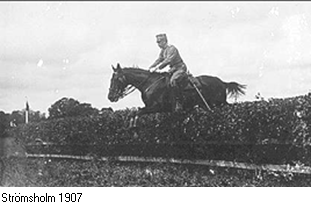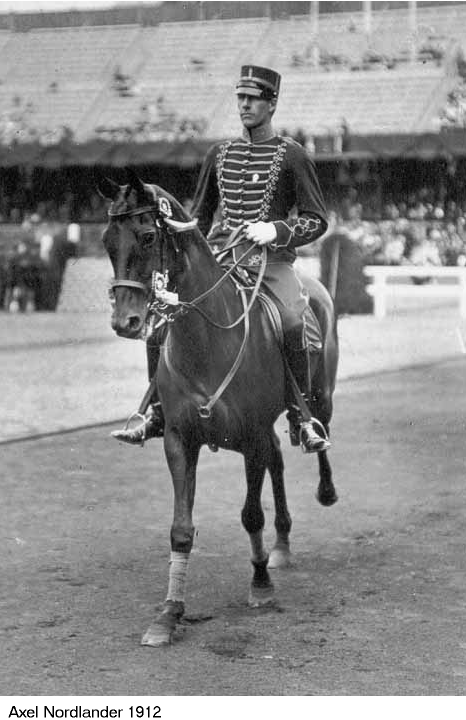The history of Eventing
Military Riding Schools are established
The most recent war that Sweden fought was against Norway, since then we have had peace for more than 200 years. The cavalry units moved their training into riding halls both in Sweden as well as on the continent. Military riding schools were established, and it is from these that eventing has its origins.
Military Riding School's activities
The military riding school in Strömsholm was founded in 1868 and was the first of its kind in Sweden. The officers were not late in creating a race and steeplechase track on the Österängarna grounds where they remains today.
Popular races and hunting rides were soon branded as useless anglomania, "an excessive interest with England" and were considered to debase the refinement of higher riding art. Anyone who wanted a brisk ride over obstacles, was often considered only as crude animal tormentor.
However, not everyone agreed, someone expressed their dissatisfaction as follows: "From the terrain, the cavalry has withdrawn into the stifling air of the riding halls, where once again immersed themselves in artifice and false refinements as well as work at shortened paces, forgetting that the conditions of life of the cavalry are speed and youthful, fresh courage to dare everything".
Endurance riding initially became very popular, but the ambitious rides took a toll on the horse resources, which worried the leadership.
A combination of endurance and riding obstacles in open terrain also took shape. The task could be to ride a marked course without any prior information where the obstacles consisted of or what was already in the terrain, such as deep ditches, fences and other challenging elements. Other exercises involved riding on horseback as quickly as possible from point A to point B.
At the beginning of the military riding school's activities, it was not easy for the officers to gain an understanding of their efforts to create good education.
Significant decisions
Change came in 1886 when the General and Baron C. A. B. Cederström, broke the ice and recommended horse racing and cross-country riding. He obtained grants for prizes at races and arranged trail hunts, which can most closely be compared to today's Hubertus hunt.
Since the late 1880s, the development of field riding has steadily advanced and the training program included distance riding, racing, hunting, individual cross-country riding, swimming and more. Cederström set a goal for the Strömsholm Riding School with the conclusion: "unconditional ability to pass all types of terrain".
The road to today´s Eventing
The first army competition was held at Strömsholm in 1907, the schedule had been composed by Nils Fischerström. This was the first Eventing in Sweden.



Jan Jönsson, bronze medallist in Eventing at the 1972 Olympics, has said that he had read an article in a competition program from Saumur in France, where it was claimed that the world's first Eventing was held in Strömsholm, Sweden. In If that is the case, the eventing in Strömsholm in 1907 would also have been the world's first eventing! In my research, I have found that the French military arranged the Military Championship in 1902, but it is not clear whether it was anything like eventing.
Eventing as a sport at the Olympics
When the Olympics were held in Stockholm in 1912, equestrian sports were included in the program for the first time. The man behind this was Clarence von Rosen, an officer in the Life Regiment's hussars, cavalry master in the army in 1907 and chief of the Royal Stables in 1916. He worked to include equestrian competitions in the Olympic program and from 1900 he was a member of the International Olympic Committee.
Clarence von Rosen became Secretary General of the Committee for the Horse Games at the 1912 Summer Olympics in Stockholm and was responsible for its equestrian competitions.
The equestrian sports were Dressage, Show Jumping and Eventing. On von Rosen's initiative, the International Equestrian Federation (FEI) was founded in 1921 and he became its honorary president in 1935.
Eventing at the time was held over three days. The first day started with endurance followed by cross-country and individual riding on the Steeplechase track. On the second day, prize jumping took place and the final day was prize riding on the program which was a form of dressage in which the judge instructed which movements were to be performed.
The Origin of Strömsholmsdagarna
When the military riding school celebrated its 50th anniversary in 1918, it was decided to arrange an equestrian competition. At that time, there was already a requirement that only associations affiliated with its central federation could organise competitions. Therefore, a new association had to be formed.The association was named ”Strömsholms Ridsportförening” (Strömsholms Equestrian Association) which was affiliated with the Swedish Equestrian Federation – SRC. In 2018, Strömsholmsdagarna celebrated its 100th anniversary!
In the schedule for the Military Competition at Strömsholm 5 – 7 July 1918, the following was described;
The competition is divided into five tests.
Each rider may participate with only one horse
Friday, July 5
1. Endurance
2. Cross-Country
3. Individual riding on the steeplechase track
Distance: 30 km - 22 km. on road, 5 km in terrain and 3 km on the steeplechase track.
Maximum time: 2 hours for the entire distance, of which 15 minutes for cross-country riding and 5 minutes for steeplechase riding.
Saturday, July 6
4. Price Jumping. (Harder.)
The obstacles may not be tested on the day of the competition by those registered for the competition.
Sunday, July 7
5. Price Riding. (Easier.)
Price table:
1:a place HRH Prince Carl's Honorary Award and SEK 1,000
2nd place Horse show in Norrköping honorary prize and SEK 400
3rd place The Ryttern women's honorary prize and SEK 250
4th place 150 kronor
5th place the stake amount up to SEK 100
6th place Possible remaining of the stake sum up to SEK 100
(With 1000 SEK in 1918 you could buy as much products and services as you today (in 2025) need 25342 SEK to buy measured by the consumer price index.
A salary of 1000 SEK in 1918 corresponded to a salary of 183570 SEK in 2025 measured by the wage index for male industrial workers (the average wage index from 1918 to 2008 was 5.43% per year while the wage increase since 2008 to 2025 has been 49.3% in total).
Source/reference: Edvinsson, Rodney, and Söderberg, Johan, 2011, A Consumer Price Index for Sweden 1290-2008 and Statistics Sweden for the period thereafter.)
Facts and quotes I have taken from the Jubilee book "The Riding School at Strömsholm 50 years on July 4, 1918" by Nils Fischerström.